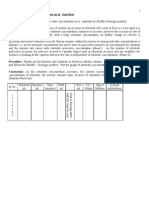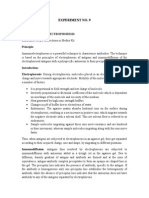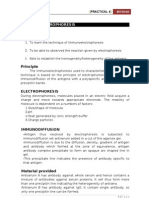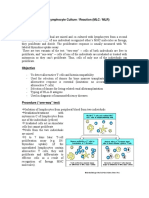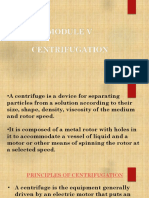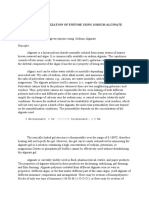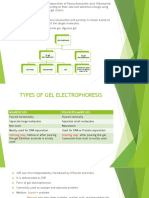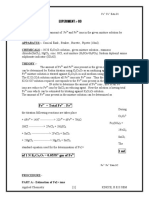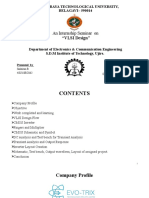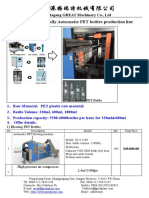Practical Immunoelectrophoresis
Practical Immunoelectrophoresis
Uploaded by
vyastrupti1Copyright:
Available Formats
Practical Immunoelectrophoresis
Practical Immunoelectrophoresis
Uploaded by
vyastrupti1Copyright
Available Formats
Share this document
Did you find this document useful?
Is this content inappropriate?
Copyright:
Available Formats
Practical Immunoelectrophoresis
Practical Immunoelectrophoresis
Uploaded by
vyastrupti1Copyright:
Available Formats
Practical# Date:
Immunoelectrophoresis
Aim: To learn the technique of immunoelectrophoresis. Principle: Immunoelectrophoresis is a powerful technique to characterize antibodies. The technique is based on the principle of electrophoresis of antigens and immunodiffusion of the electrophoresed antigens with a polyspecific antiserum to form precipitin bands. Electrophoresis: During electrophoresis, molecules placed in an electric field acquire a charge and move towards appropriate electrode. Mobility of the molecule is dependent on a number of factors: It is proportional to field strength and net charge of the molecule. Inversely proportional to frictional coefficient of the molecule which is dependent on size / shape of the molecule and viscosity of the medium. Heat generated by high ionic strength buffers. Changes in pH of buffer due to electrolysis of water. Endosmosis Thus, when antigens are subjected to electrophoresis in an agarose gel, they get separated according to their acquired charge, size, and shape, by migrating to different positions. Immunodiffusion: Antigens thus resolve by electrophoresis are subjected to immunodiffusion with antiserum added in a trough cut in agrarose gel. Due to diffusion, density gradient of antigen and antibody are formed and at the zone of equivalence, antigen-antibody complex precipitates to form and opaque arc shaped line in the gel. The precipitin line indicates the presence of antibody, specific to the antigen. If the antibody is homogenous only one precipitin line is visible. Presence of more than one precipitin line established the heterogeneity of antibody, while the absence of precipitin line indicates that the antiserum does not have antibody to any of the antigens separated by electrophoresis. Materials provided: Agarose, 5X Electrophoresis Buffer, Antigen, Test Antiserum-A and B. Materials required: Conical flask, Measuring cylinder, Distilled water, Micropipette, Tips, Moist chamber (box with wet cotton). Procedure: Preparation of Buffer: Dilute 40ml of 5X Electrophoresis Buffer to 1X concentration with distilled water, i.e 40 ml of Electrophoresis Buffer + 160 ml of distilled water, mix well to obtain 200 ml of diluted 1X Electrophoresis Buffer.
Practical# Date:
Preparation of gel plate: 1. Prepare 10 ml of 1.5 % agarose (0.15g/10 ml) in 1X Electrophoresis Buffer by heating slowly till agarose dissolves completely. Take care not to scorch/froth the solution. 2. Mark the end of a glass plate that will be towards negative electrode during electrophoresis. 3. Place the glass plate on a horizontal surface. Pipette and spread 10 ml of agarose solution onto the plate. Take care that the plate is not disturbed and allow the gel to solidify. 4. Place the glass plate on the template holder provided in the kit and fix the template. Punch a 3mm well with the gel puncher as shown in figure, towards the negative end. 5. Cut two troughs with the gel cutter provided, but do not remove the gel from the trough. Electrophoresis 6. Add 12-15l of Antigen to the well. 7. Place the glass plate in the electrophoresis tank such that the Antigen well is at the cathode/negative electrode. Pour 1X Electrophoresis Buffer such to cover the gel. 8. Set the voltage to 50-100V and electrophorese until the blue dye travels 3-4 cms from the well. NOTE: Do not electrophorese beyond 3 hours, as it is likely to generate heat. Immunodiffusion: 9. Remove gel from both the troughs and keep the plate at room temperature for 15 min. Add 250 l of antiserum-A in one of the troughs and antiserum- B in the other. 10. Place the plate in a moist chamber and allow diffusion to occur at room temperature, overnight. Observation: Observe for precipitin lines between antiserum troughs and the antigen well. Interpretation: Presence / absence of precipitin line indicates the presence / absence of antibody specific to the antigen, respectively. Presence of more than one line indicates the heterogeneity of the antiserum to the antigen. Presence of a single precipitin line indicates homogeneity of the antiserum to the antigen.
Practical# Date:
You might also like
- Effect of Substrate Concentration on α -AmylaseDocument26 pagesEffect of Substrate Concentration on α -Amylasepriyaa100% (5)
- ImmunoelectrophoresisDocument3 pagesImmunoelectrophoresiskashishNo ratings yet
- Experiment-2 Rocket Immunoelectrophoresis: By: Abhishek Shetye Sharvari Sangle Shital PatilDocument15 pagesExperiment-2 Rocket Immunoelectrophoresis: By: Abhishek Shetye Sharvari Sangle Shital PatilAbhi ShetyeNo ratings yet
- IMMUNOELECTROPHORESISDocument4 pagesIMMUNOELECTROPHORESISkiedd_0460% (5)
- SRIDDocument4 pagesSRIDd_caasiNo ratings yet
- Dot-ELISA Practical Manual 2Document4 pagesDot-ELISA Practical Manual 2Anusua RoyNo ratings yet
- Biosensor Lab (SBFT) : Standard Operating Procedure FOR Gel Electrophoresis UnitDocument2 pagesBiosensor Lab (SBFT) : Standard Operating Procedure FOR Gel Electrophoresis UnitVijayDubeyNo ratings yet
- Haemodialysis Solutions ForDocument3 pagesHaemodialysis Solutions ForTaurusVõNo ratings yet
- Size SeparationDocument53 pagesSize SeparationvodounnouNo ratings yet
- Gelatin - Alfida PDFDocument3 pagesGelatin - Alfida PDFalfidaNo ratings yet
- Nanodrop InstrumentDocument4 pagesNanodrop InstrumentMustafa Khandgawi100% (1)
- Dna Estimation by Dpa MethodDocument1 pageDna Estimation by Dpa MethodPraveen RoylawarNo ratings yet
- Immunochemical Techniques: Amrita BhowmikDocument85 pagesImmunochemical Techniques: Amrita BhowmikisaazslNo ratings yet
- IsoenzymeDocument4 pagesIsoenzymeshekinah656No ratings yet
- Isolation of Genomic DNADocument16 pagesIsolation of Genomic DNASamra KousarNo ratings yet
- Reference Electrode: ConstructionDocument15 pagesReference Electrode: ConstructionMeghana PNo ratings yet
- Core Practical - Gel ElectrophoresisDocument3 pagesCore Practical - Gel ElectrophoresisDhruv ChopraNo ratings yet
- GATE XL 2013 Exam Microbiology Solved Question Paper PDFDocument5 pagesGATE XL 2013 Exam Microbiology Solved Question Paper PDFMichael JeevaganNo ratings yet
- MLS 425 Chemical Pathology I Lecture NoteDocument55 pagesMLS 425 Chemical Pathology I Lecture NoteMayowa Ogunmola100% (1)
- Volutin Granule StainingDocument2 pagesVolutin Granule StainingRajeev PotadarNo ratings yet
- Hiper Widal Test Teaching Kit (Slide Test)Document7 pagesHiper Widal Test Teaching Kit (Slide Test)gaming with garryNo ratings yet
- SBL 1023 Lab 9 Exp Gram Staining AsepticDocument10 pagesSBL 1023 Lab 9 Exp Gram Staining Asepticapi-384057570No ratings yet
- Carbohydrate Structural ElucidationDocument27 pagesCarbohydrate Structural Elucidationbhavanagowda252No ratings yet
- Hyphenated TechniquesDocument23 pagesHyphenated TechniquesMuhammad KashifNo ratings yet
- Ord Lecture NotesDocument44 pagesOrd Lecture NotesPayalshelkeNo ratings yet
- Polymeric NanoparticlesDocument28 pagesPolymeric Nanoparticlesvending machineNo ratings yet
- Mixed Lymphocyte Culture / Reaction (MLC / MLR)Document2 pagesMixed Lymphocyte Culture / Reaction (MLC / MLR)Muthi KhairunnisaNo ratings yet
- PPTDocument30 pagesPPTAiman100% (1)
- DR JamesTJ CentrifugationDocument66 pagesDR JamesTJ CentrifugationSumaiyaNo ratings yet
- Titrimetric Methods of AnalysisDocument82 pagesTitrimetric Methods of AnalysisMeseret KifileNo ratings yet
- Dhona Balance001Document1 pageDhona Balance001nitinNo ratings yet
- Spectrophotometry Basic ConceptsDocument7 pagesSpectrophotometry Basic ConceptsVon AustriaNo ratings yet
- KT106 GeNei™ Immunoglobulin G Isolation Teaching KitDocument9 pagesKT106 GeNei™ Immunoglobulin G Isolation Teaching KitHemant KawalkarNo ratings yet
- Practical - Immobilization of EnzymesDocument4 pagesPractical - Immobilization of EnzymesAditi Patil100% (2)
- Preparation of Stained Temporary Mounts of Onion PeelDocument2 pagesPreparation of Stained Temporary Mounts of Onion PeelAnirudh100% (1)
- DNA Isolation From Spleen ProtocolDocument2 pagesDNA Isolation From Spleen ProtocolSherlock Wesley ConanNo ratings yet
- Experiment No: Immobilization of Enzyme Using Sodium AlginateDocument3 pagesExperiment No: Immobilization of Enzyme Using Sodium AlginateVijayasarathy Sampath Kumar100% (1)
- 2 D Electrophoresis 1Document8 pages2 D Electrophoresis 1Vanshika AroraNo ratings yet
- Practic Le 6Document3 pagesPractic Le 6Mehul KhimaniNo ratings yet
- Separation of Ink Mixture Using Paper Chromatography TechniqueDocument2 pagesSeparation of Ink Mixture Using Paper Chromatography TechniqueSevar Abdullah100% (1)
- L 2 - AmperometryDocument19 pagesL 2 - AmperometryMd. Zd HasanNo ratings yet
- Complement Fixation Test تقرير د-حيدر-محولDocument5 pagesComplement Fixation Test تقرير د-حيدر-محولYASMINANo ratings yet
- Half Wave Potential 2Document9 pagesHalf Wave Potential 2Mohamed Al SharfNo ratings yet
- Practical Sulphonamides by ColorimetryDocument9 pagesPractical Sulphonamides by ColorimetryDr Nilesh PatelNo ratings yet
- Medicinal Chemistry I Lab ManualDocument42 pagesMedicinal Chemistry I Lab Manualmagician28No ratings yet
- Lab Report MicrobiologyDocument11 pagesLab Report Microbiologysalman ahmedNo ratings yet
- Determination of KlaDocument12 pagesDetermination of KlaKaycee ChirendaNo ratings yet
- Lab No 4 PathologyDocument4 pagesLab No 4 PathologyRafay KayaniNo ratings yet
- PumeetDocument46 pagesPumeetDipin Preet SinghNo ratings yet
- BRIX-Sugar Determination PDFDocument8 pagesBRIX-Sugar Determination PDFNovianti NoviNo ratings yet
- Widal Test Teaching Kit (Tube Test)Document6 pagesWidal Test Teaching Kit (Tube Test)Jeje Mystearica100% (1)
- Sds-Polyacrylamide Gel Electrophoresis IntroductionDocument5 pagesSds-Polyacrylamide Gel Electrophoresis IntroductionmejohNo ratings yet
- Honey MoistureDocument2 pagesHoney MoistureMoh. andi sulaiman100% (1)
- Dot ELISADocument8 pagesDot ELISAYho NgNo ratings yet
- Blood Sugar Estimation by GODDocument4 pagesBlood Sugar Estimation by GODChimple MaanNo ratings yet
- Experiment:-03: AIM: - To Estimate The Amount of FeDocument3 pagesExperiment:-03: AIM: - To Estimate The Amount of Fedcool3784No ratings yet
- Size Exclusion ChromatographyDocument15 pagesSize Exclusion ChromatographySumble AhmadNo ratings yet
- Counter Current ImmunoelectrophoresisDocument2 pagesCounter Current ImmunoelectrophoresisNandhini D PNo ratings yet
- Exp.7. Counter Current ImmunoelectrophoresisDocument2 pagesExp.7. Counter Current ImmunoelectrophoresisHarsha AnandNo ratings yet
- Sterilization: Fundamental Principles of Bacteriology - A J SalleDocument9 pagesSterilization: Fundamental Principles of Bacteriology - A J Sallevyastrupti1No ratings yet
- Simple StainingDocument2 pagesSimple Stainingvyastrupti1No ratings yet
- Spirochete StainingDocument2 pagesSpirochete Stainingvyastrupti175% (4)
- AlcoholDocument3 pagesAlcoholvyastrupti1No ratings yet
- Practical Dot ElisaDocument3 pagesPractical Dot Elisavyastrupti1100% (1)
- The Study of Bus Superstructure Strength Based On Rollover Test Using Body SectionsDocument8 pagesThe Study of Bus Superstructure Strength Based On Rollover Test Using Body SectionsIvan ObandoNo ratings yet
- Wiring and Test - Adafruit AGC Electret Microphone Amplifier - MAX9814 - Adafruit Learning SystemDocument2 pagesWiring and Test - Adafruit AGC Electret Microphone Amplifier - MAX9814 - Adafruit Learning SystemRonaldMartinezNo ratings yet
- Hydron PVC BrochureDocument28 pagesHydron PVC BrochureNitesh SuhagNo ratings yet
- C++ ModuleDocument77 pagesC++ Modulehabtamulamesa8No ratings yet
- An Internship Seminar On: "VLSI Design"Document21 pagesAn Internship Seminar On: "VLSI Design"sooraj naikNo ratings yet
- Blockchain IntroDocument30 pagesBlockchain IntroROHETH SNo ratings yet
- B 812 Cfa 38Document8 pagesB 812 Cfa 38Sajid AliNo ratings yet
- 5 MATRIKULASI CostingDocument27 pages5 MATRIKULASI CostingpuspaNo ratings yet
- Modification of EMMEDUE M2 Building System: Civil Department, Faculty of Engineering Modern University, EGYPTDocument12 pagesModification of EMMEDUE M2 Building System: Civil Department, Faculty of Engineering Modern University, EGYPTCristian Angel C LNo ratings yet
- CPBO423 - Lesson 3 - Instruction Sets-Characteristics and FunctionsDocument49 pagesCPBO423 - Lesson 3 - Instruction Sets-Characteristics and FunctionsMichaelangelo AlvarezNo ratings yet
- Professional Achiever Plus Heavy Duty Power VentDocument2 pagesProfessional Achiever Plus Heavy Duty Power VentjoeNo ratings yet
- 6cavity Automatic PET Blow Molding Machine Offer Line PDFDocument9 pages6cavity Automatic PET Blow Molding Machine Offer Line PDFMakuku D. J. Sam100% (1)
- DOR-230 PCB #1 Signal Input Error: Point of Detection ApplicationDocument1 pageDOR-230 PCB #1 Signal Input Error: Point of Detection ApplicationDaniel GatdulaNo ratings yet
- Project 4-6 Answer Sheet Recognize Common Performance Improvement Tools StudentDocument2 pagesProject 4-6 Answer Sheet Recognize Common Performance Improvement Tools Studentlisadhatch50% (2)
- Assembly Instructions Quick Connect System 231Document12 pagesAssembly Instructions Quick Connect System 231Jason KozminskaNo ratings yet
- Final SOW-HVOF Coating On Boiler ChannelDocument29 pagesFinal SOW-HVOF Coating On Boiler ChannelCorrosion FactoryNo ratings yet
- US3824496Document7 pagesUS3824496eliudetrovaomoraesNo ratings yet
- Light in The World of Nanotechnology - Schneider (Springer Essentials) (2022)Document45 pagesLight in The World of Nanotechnology - Schneider (Springer Essentials) (2022)sherNo ratings yet
- MDocument1 pageMlohithsuresh.bNo ratings yet
- 520702newhouse 1968 BakerDocument68 pages520702newhouse 1968 BakerMrin MoyNo ratings yet
- 18 SUQUERY in SELECT ClauseDocument13 pages18 SUQUERY in SELECT ClauseAngel Pérez L.No ratings yet
- ABAQUS XFEM 3D Penny Crack (Step by Step)Document2 pagesABAQUS XFEM 3D Penny Crack (Step by Step)Guoyang FuNo ratings yet
- Link Budget - Getting StartedDocument31 pagesLink Budget - Getting StartedAnonymous zBSE9MNo ratings yet
- Dens Invaginatus: Aetiology, Classification, Prevalence, Diagnosis and Treatment ConsiderationsDocument8 pagesDens Invaginatus: Aetiology, Classification, Prevalence, Diagnosis and Treatment ConsiderationsNur Hasnah HasibuanNo ratings yet
- Manual d7r BNXDocument1,011 pagesManual d7r BNXivanNo ratings yet
- Cow S Milk Allergic ChildrenDocument12 pagesCow S Milk Allergic ChildrenNurul Huda KowitaNo ratings yet
- LTE Design Guide - EN - DigitalDocument20 pagesLTE Design Guide - EN - DigitalAteliê 01No ratings yet
- Dose Reduction Techniques1Document4 pagesDose Reduction Techniques1eltonNo ratings yet
- Time-Series Analysis and Forecasting: Least Squares MethodDocument17 pagesTime-Series Analysis and Forecasting: Least Squares Methodveer12311No ratings yet
- 9 Differential EquationsDocument12 pages9 Differential EquationsHarsh RaviNo ratings yet
